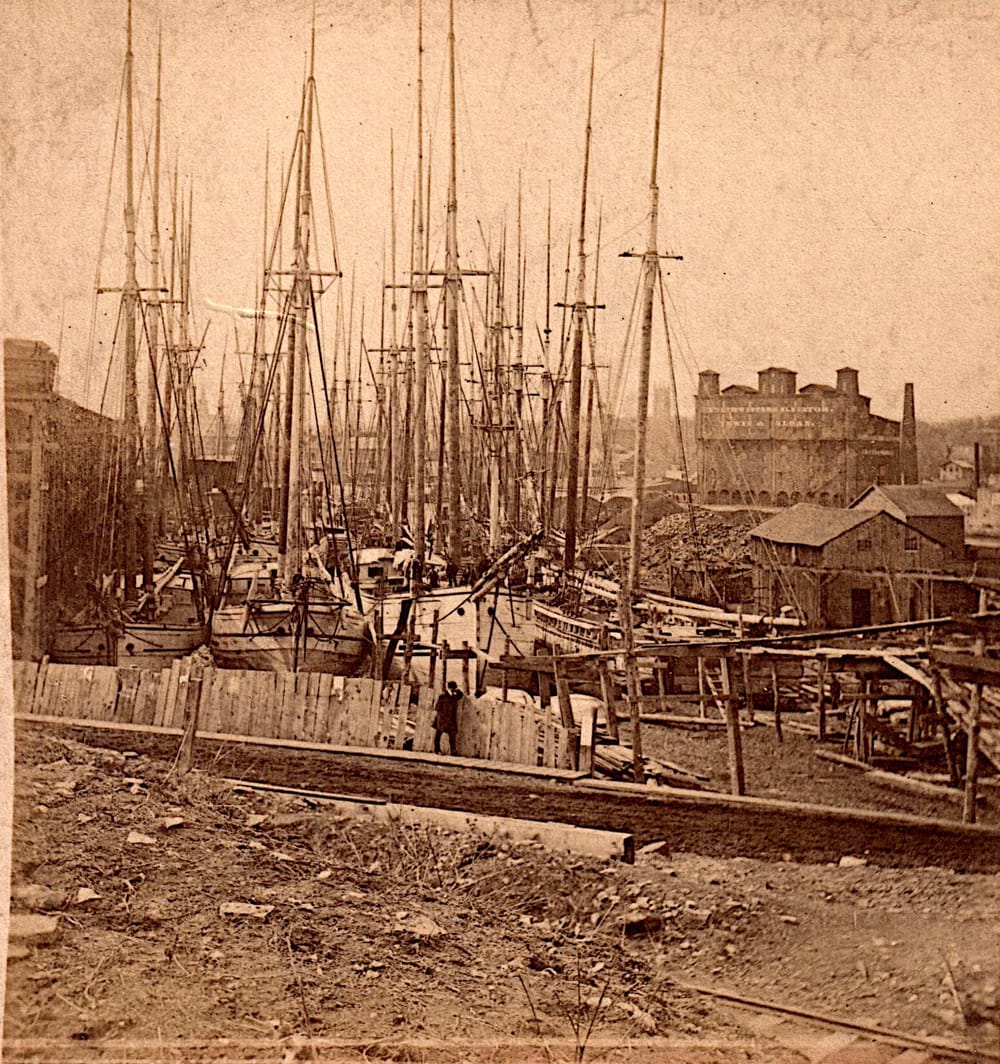"Spring Fit-out" on the Great Lakes, Part I
by: Richard Palmer
In the mid-19th century, as many as one hundred ships wintered in such ports as Oswego. As soon as the ice melted, Oswego came alive like a bear awakening from its long winter’s nap. In fact, fitting out is described as a particularly interesting routine to watch, seemingly well organized down to every detail. The newspapers are suddenly filled with advertisements from the local ship chandleries, grocery, clothing, boot, and shoe stores.
Also, soon appearing were the new spring schedules of the steamboat lines serving Lake Ontario and the St. Lawrence River. Everyone read with interest the list of captains and their vessel assignments, which could take up half a newspaper column. Oswego, in those days of sail had the infrastructure required to support the mammoth commerce for which it was then famous — from sailmakers to the iron foundries that produced such maritime related items as capstans, winches, anchors, and steering mechanisms. The ship chandleries catered to sailors with the latest mariners’ tools — compasses, barometers, spyglasses, marine clocks, and other nautical instruments.
Old newspaper editors gave colorful descriptions of the period of fitting out. Each one provides a glimpse back in time.
The Harbor — The work of fitting out vessels preparatory to the opening of spring business has commenced in our harbor, and the sound of the caulking hammer, and the cheery voices of the sailors will be heard again. The work of refitting vessels is fairly begun, yesterday and today being the busiest of the season. Quite a number of vessels are taking on their canvas, and soon our noble blue Ontario will be flecked with snowing sails – We’re glad of it. Oswego Palladium, April 8, 1864
The harbor presents a gala appearance today, a large fleet of grain and lumber vessels being in port. Such a forest of spars has not been seen on the river since the good old days of yore, when Oswego rivalled the grain receiving ports of the lower lakes. Oswego Daily Palladium, May 18, 1874
Winter is over
Oswego residents could sense the navigation season rapidly approaching, when sailors left their winter quarters at the local hotels and boarding houses and hurried to the waterfront to fit out their vessels, idle for five months. For owners time was money, and there was always a flurry to get these vessels seaworthy. At times, the harbor was so busy that one could easily cross the Oswego River by hopping from deck to deck.

During the winter of 1859-1860, there were 68 sailing vessels and 80 canal boats laid up in the harbor. In the off season one would be hard pressed to find a room for the night, as the local hotels and boarding houses serving as winter quarters for hundreds of sailors.
The docks, shipyards, and satellite businesses employed hundreds of men and boys. The maritime life of Oswego centered on the First Ward, the waterfront of the west side, and the Second Ward, on the east side. The 1850s, 1860s, and 1870s was a period of prosperity and activity for Oswego harbor. To this city came masses of European immigrants to work in the shipyards and factories.
Fitting out vessels was a ritual dating back to the dawn of navigation. It was a time when Oswego resembled an ocean seaport, the harbor was choked with vessels, reflected in the newspapers of the day. Canal boats with merchandise from the Hudson are rapidly coming in. On the whole, the movement and business of the day assumes a cheering aspect. Oswego Commercial Times, May 20, 1856.
The Spring Fleet. - Our wharves and river have this morning truly assumed the bustling appearance and busy hum of spring. The sun shines out warm and bright upon the river, so crowded on either side by the western fleet of yesterday as to show only a contracted, silvery streak stretching up its center to mark the channel. Under the elevators this morning the vessels lie in a tier six deep and yet still they come. Our harbor presents today one of the most animating scenes. A change of wind has brought in a large fleet of sail vessels and the British and American flags float gaily from many steam vessels in the harbor. There are four propellers of the Northern Transportation Line in port loading and discharging cargoes. - Oswego Commercial Times, April 28, 1858.
It is certainly refreshing to look upon the business activity prevailing in our harbor at the present time, after the usual stagnation of the winter months in all northern lake ports. The click of the mallet resounded on every side – the decks of the numerous vessels are manned with busy crews engaged in “fitting out,” and everything presents an aspect of business. Everybody predicts a season of prosperity. May these predictions be verified, and the approaching season redeem the losses of the past. Vessels are arriving and departing daily, and our businessmen are actively engaged in completing their arrangements for heavy commercial transactions. - Oswego Commercial Times, April 3, 1860
Navigation
Vessels in our harbor are now commencing to fit out. We noticed several this morning on which men were engaged in arranging rigging, &c. The opening of active business, however, will depend on the time the Canadian authorities open the Welland Canal. The severe cold of the present month will probably prolong this desirable event, but before many weeks we will again hear the din and business of commercial transactions on our docks. - Oswego Commercial Times, March 24, 1863
The early opening of navigation is causing considerable activity among the lake craft in our harbor. Many vessels have already bent their canvas and are only awaiting the opening of the Welland Canal to clear for upper lake ports. A large quantity of grain has been kept afloat at this place during the winter, and is now being stored in warehouses or transferred to canal craft, for transportation to the East. We notice many of the latter craft already loaded and lying in the basin above the Iron Bridge awaiting the opening of the ditch. (Referring to the Oswego Canal). - Oswego Commercial Times, April 5, 1864.
Fitting out
The Oswego Times and Journal of March 31, 1854, offers a glimpse of the waterfront excitement of fitting out:
We took a stroll yesterday down among the shipping and our ears were greeted on every side by the Merry Yo! Heave Ho! of the sailor getting his craft ready for sea, and the click of the caulkers’ irons, which to us are pleasant sounds, denoting as they do the opening of a season ever busy in our city. We noticed that the Oxford, which was used so roughly in a gale last fall, recovering her former appearance. Both her spars were carried away – and in fact everything above deck – which are now being replaced by the finest looking “sticks” we have ever seen.
The propeller Dayton has just arrived from Toronto with 3,500 barrels of flour and 800 bushels of peas, which she was discharging at the government warehouse. The main channel of our harbor is free from ice, so that the arrival and departure of vessels is not in the least difficult.
The Oswego Times and Journal of April 26, 1856 reflects:
A general fitting out of the craft in our harbor is going on, which makes business extremely active. Jolly tars are seen dangling from the peak down to the lower ratline, and busy as bees, getting their ship ready for sea: painting, scraping, tarring, caulking, greasing, reeving, &c., &c. Nothing to us looks more cheerful than scenes like these, where industry and agility are combined with labor. Then occasionally comes the “cheerily up boys,” from down the stream, as the winter cable is taken in and stowed away - “all pleasant sounds.”

Oswego's shipyards
In those antebellum days there were fortunes to be made and Oswego’s three or four shipyards were turning out vessels to meet the demands of the grain and lumber merchants who also owned the elevators that lined the banks of the Oswego River. Schooners are said to have virtually monopolized the bulk carrier trade at the time. No expense was spared on these vessels and only the best materials were used. They were the pride of the master carpenters who built them to strict underwriter’s specifications.
Even artists were employed to letter them and paint colorful scenes on transoms.
Spring fit-out was an exciting time of year on the waterfront. The sailors would be chanting:
Hey they’re bowlin’, the captain he is growling.
Hey they’re bowlin’, heave and haul!”
Some vessels required more work than others. A marine reporter for the Oswego Palladium on March 10, 1875, detailed the major work being done on the 28-year-old schooner Carlton to make her seaworthy. Although her frames and floor timbers were still sound:
The owner of the Carlton, Charles Guthrie, will spare no expense to put the vessel in good shape, and judging from the work already done he will succeed. She will receive new ceilings throughout, the bilges being three-inch oak bolted through on every frame, and the rest of the ceiling oak plank two and a two and a half inches thick. As soon as the weather will permit, she will be taken on the dry dock and a seven-inch keelson will be put on the present one and securely bolted. New stanchions will be supplied wherever needed, and she will be given new bulwarks and stringer. Her stern, which was damaged last fall, has received all new work and is now quite presentable. The repairs, which are under the supervision of an excellent ship-carpenter, John Shepard, will cost over $1,500. Captain John Gibson is giving his attention to the work in hand.
Conclusion
As was written in 1864: The early opening of navigation is causing considerable activity among the lake craft in our harbor - 2023 is not very different. However the ocean-going ships and the many private yachts and fishing boats look different, yet the excitement of a good summer ahead is exactly the same. May your launch days go well and may the winds be at your back.
By Richard F. Palmer
Richard Palmer is a retired newspaper editor and reporter, and he was well known for his weekly historical columns for the “Oswego Palladium-Times,” called "On the Waterfront." His first article for TI Life was written in January 2015, and since then, he has written over 20 more. He is a voracious researcher, and TI Life readers certainly benefit from his interests.
See Part II coming in May 2023.






Please click here if you are unable to post your comment.